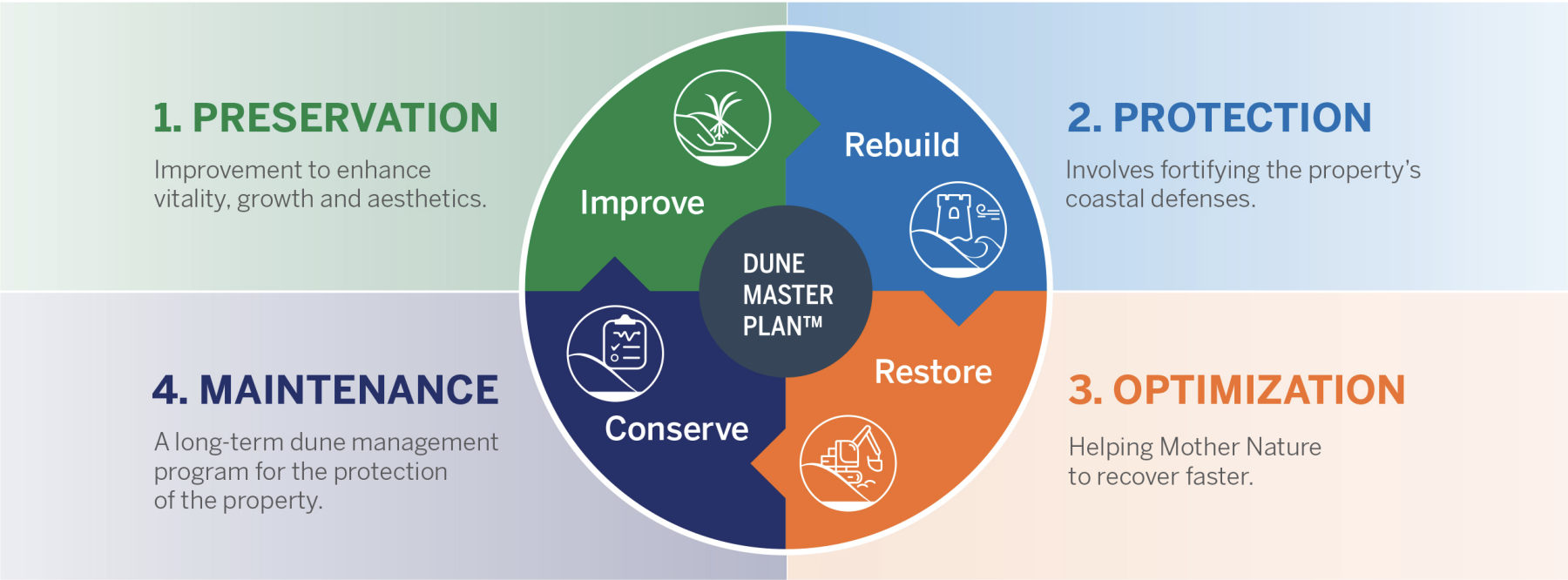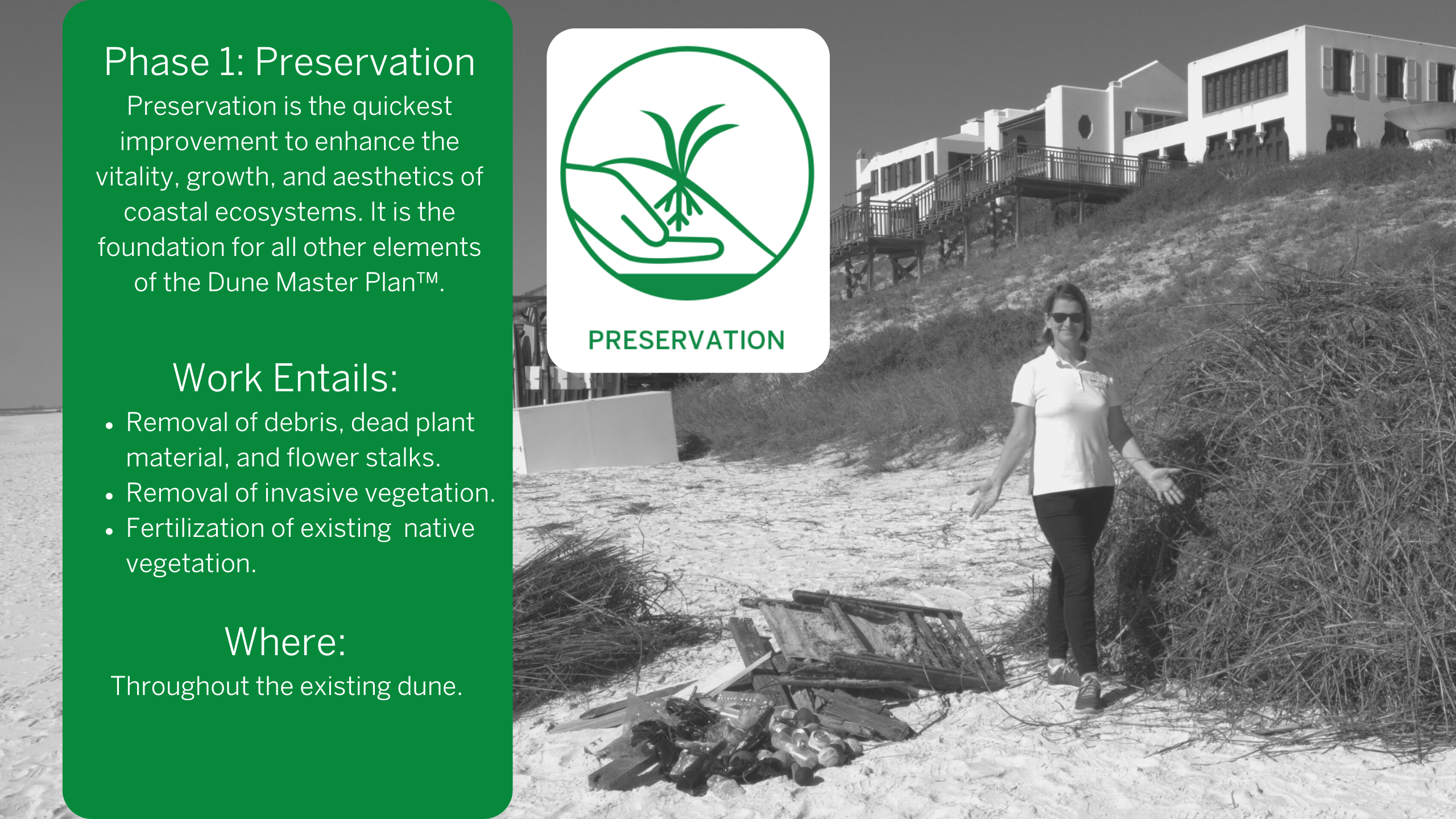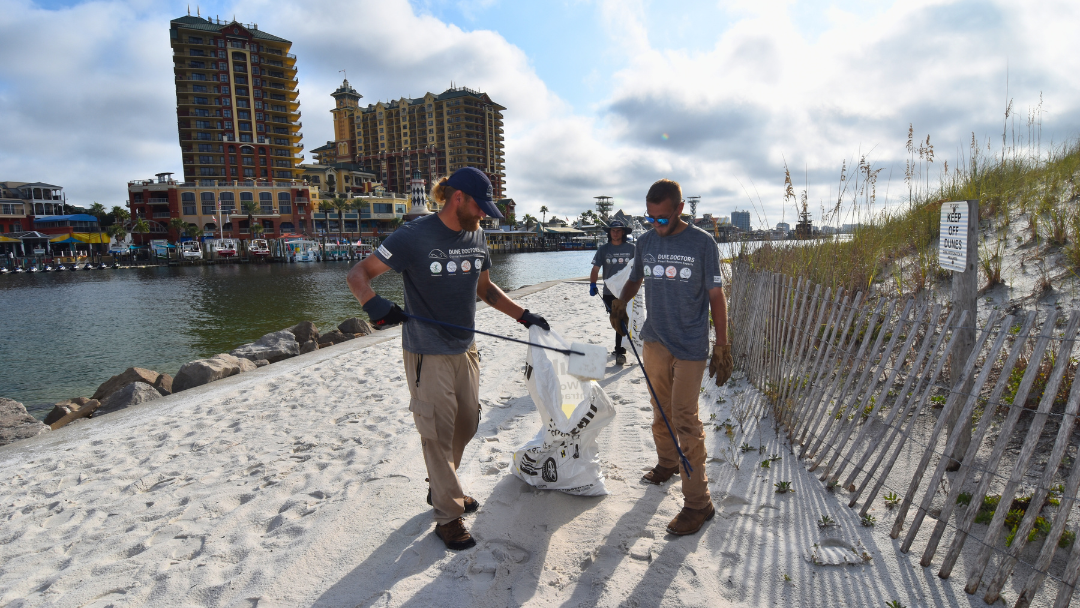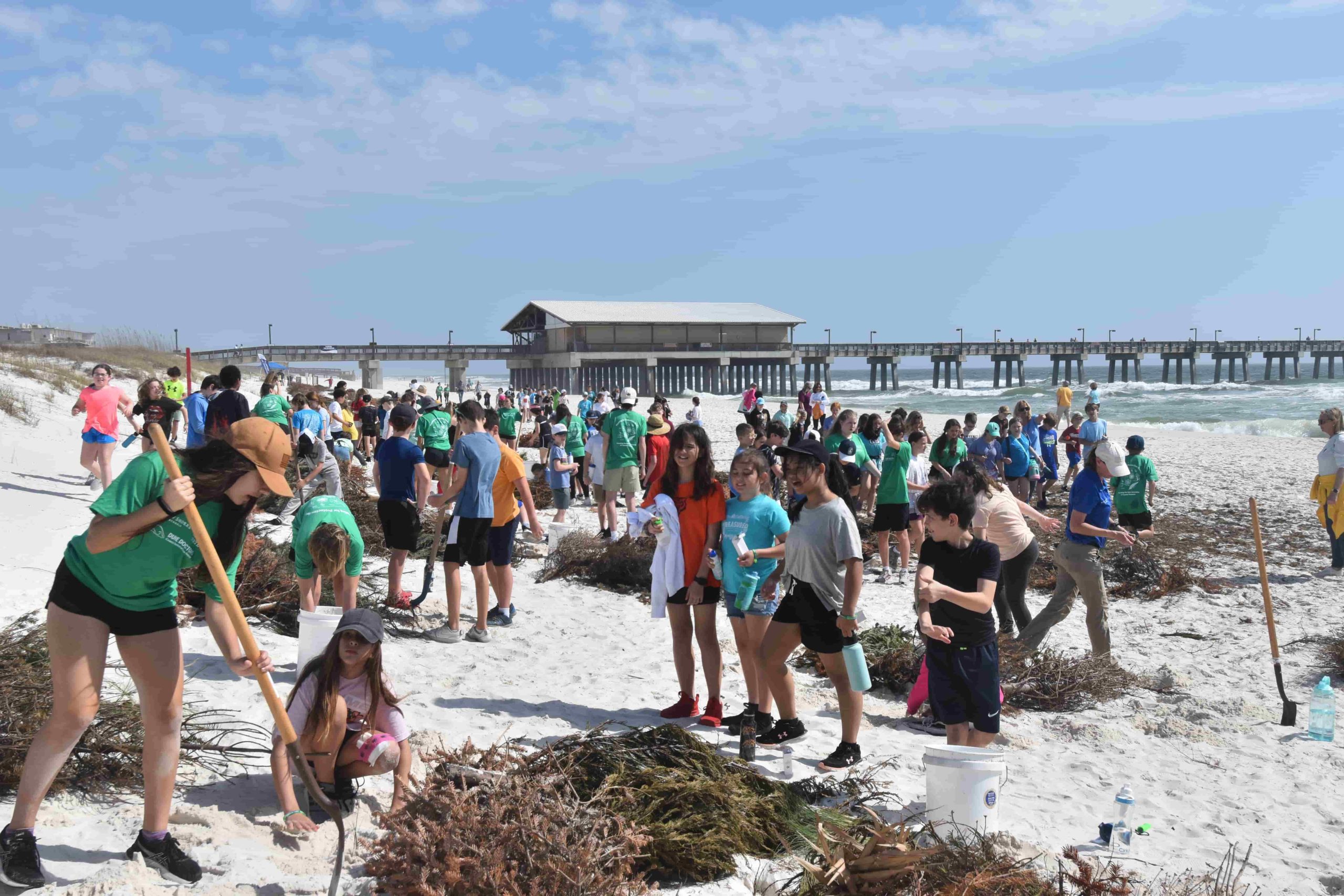Article Highlight: The Dune Master Plan™ is a long-term roadmap for coastal resiliency that streamlines the restoration and ongoing management of a dune system into four integrated phases.
Key Takeaway: The dune ecosystem is a natural barrier against destructive storm surge along the Gulf Coast. Proactive homeowners can enlist Dune Doctors’ help to stabilize, strengthen and maintain this native protective landscape.
Fast Application: Request a site visit today by filling out this form or calling Dune Doctors at 866-386-3737. After visiting your property to identify its strengths and any weaknesses, our Coastal Restoration Experts will develop a personalized Dune Master Plan™.
The Dune Master Plan™

Coastal dunes are critical to the survival of waterfront communities and are therefore heavily-regulated and require ongoing care. For over twenty years, Dune Doctors has worked alongside local and federal agencies to restore and naturally fortify this native landscape while encouraging property owners to regard it as a valuable asset that must be invested in, respected, and cared for. Through thousands of successful projects, Dune Doctors has streamlined its expertise into the Dune Master Plan™, a long-term roadmap for coastal resiliency that addresses every aspect of building and maintaining a protective dune system in compliance with environmental regulations. Below is an introduction to the four phases of the Dune Master Plan™. To learn more about our expertise click here.
Phase 1: Preservation – The Foundation of the Dune Master Plan™

Most properties along the Gulf Coast have an existing dune system, whether that be a dune with established vegetation or bare mounds with sparse grasses. Phase 1 of the Dune Master Plan™ (DMP™) focuses on this existing dune system to preserve and revitalize the native plants that currently stabilize it. The complex root systems of these coastal plants are the only force holding the property’s dune in place. Until further restoration efforts can be implemented, this existing dune is often the property’s only protection against storm surge (Click here to learn more about the plants that stabilize coastal dunes). Through Phase 1, Dune Doctors revitalizes the existing dune-stabilizing plants to prepare a healthy foundation for the other phases of the DMP™.
What does Phase 1 Entail?
• First, Dune Doctors removes any build-up of trash, thatch (dead plant material), and invasive vines from the dune system.
• After the harmful elements are extracted, our restoration experts fertilize the native coastal vegetation to strengthen their root systems. (Click here to learn more about dune fertilization.)
What is the Outcome of Phase 1: Preservation?
When a proactive homeowner selects to invest in Phase 1, their immediate gain is a safer and more aesthetically pleasing environment for beachgoers. Their long-term outcome is a resilient web of deep, healthy root systems that anchors their dune in place. Through Preservation, Dune Doctors lessens the presence of invasive animals (Click here to learn how to deal with invasive rats and snakes), extracts the invasive vegetation, and removes the conditions that can lead to dune fires and the spread of plant diseases (Click here to learn more about the benefits of Phase 1). In addition to cleaning the dune, our Coastal Restoration Experts also apply a seaweed-based fertilizer to encourage plant growth. Preservation should be a one-time investment if Dune Doctors consistently maintains the dune. Otherwise, Phase 1 must be implemented, on average, every 3 years.
Phase 2: Protection – The Core of Coastal Resiliency

After revitalizing the native vegetation, Dune Doctors focuses on initiating new lines of defense (berms) between the homeowner and the water. In Protection: Phase 2 of the Dune Master Plan™, our Coastal Restoration Experts work with local and federal environmental authorities to install wildlife-friendly sand fences and dune-stabilizing plants seaward of the existing dune (click here to learn more about sand fences). Dune Doctors’ strategic installation method accelerates the rate at which berms develop. As the sand fences trap moving sand, the plants stabilize it. Through Phase 2 of the Dune Master Plan™, Dune Doctors naturally fortifies the native coastal landscape by adding a continuous berm that functions as a barrier against storm surge and helps replenish eroding beaches.
What Does Protection: Phase 2 Entail?
• First, Dune Doctors installs both environmentally compliant sand fences and dune-stabilizing native grasses and flowers.
• Next, our Coastal Restoration Experts install no-trespassing signs to discourage beachgoers from walking on the developing berm. (Click here to find out more ways to protect your developing berm.)
• Finally, if the boardwalk ends before the fence installation, Dune Doctors ropes off a pathway from the bottom of the boardwalk through the fences to limit foot traffic erosion and create safe passage for beachgoers.
What is the Outcome of Phase 2: Protection?
When a proactive homeowner selects Protection: Phase 2, they create a sacrificial barrier of free sand that can help absorb the impacts of potential future storms, mitigating damages to the dune closest to the property and the foundation of their coastal home. On average, it takes between two to six years for enough wind-blown and surge-borne sand to accumulate and cover properly installed sand fences. Once less than one foot of sand fences remains to be buried, our Coastal Restoration Experts recommend installing an additional row to initiate the next berm. Because the fences create a continuous berm, Dune Doctors strongly encourages proactive neighbors to achieve protection together by connecting their fence installations.
Phase 3: Optimization – The Solution to Erosion-prone Areas

Optimization: Phase 3 is the most expansive phase of the Dune Master Plan™ and aims to strengthen the most critical barrier against storm surge: the existing dune. As the final barrier between the homeowner and water-borne threats, the most landward dune is a highly valuable asset that must be invested in and cared for. Dune Doctors uses Phase 3 to strategize sustainable and scalable projects that repair failure points and erosion-prone areas throughout the dune. Phase 3 may include adding sand to fill in depressions to aiding in the design of boardwalks that account for the dune’s seaward progression. Click here to learn more about how boardwalk design impacts coastal resiliency.
What does Optimization: Phase 3 entail?
- First, Dune Doctors identifies erosion threats and, if needed, engages our panel of architects, engineers, and construction partners to deliver the ideal solution.
- Second, our Coastal Restoration Experts install native plants to stabilize bare areas.
- Third, if the dune has progressed past the boardwalk, Dune Doctors aids in designing a new boardwalk that takes the dune’s evolution into account and in correcting any damages to the dune during the removal of the old boardwalk and installation of the new one.
- Fourth, Dune Doctors plants coastal flowers to enhance the natural aesthetics of the dune and increase plant diversity. View our plant selection here.
What is the Outcome of Phase 3: Optimization?
When a proactive homeowner selects Optimization: Phase 3, Dune Doctors works to identify and address erosion threats posed to their protective native landscape and the foundation of their coastal property. Optimization is a one-time investment unless the dune sustains any damage. Click here to learn more about the different solutions for varying levels of erosion.
Phase 4: Maintenance – Longterm Management for Coastal Resiliency

All four phases of the Dune Master Plan™ cultivate the dune system to create the ideal environment for sand to accumulate and for native vegetation to grow and spread. Through Maintenance: Phase 4, Dune Doctors monitors and strengthens the growing dune system, including the existing dune and developing berm. Uninterrupted dune maintenance counters the erosive forces acting upon this native protective landscape and sustains the investments made through the other phases. Dune Maintenance requires a specialized understanding of the ecosystem. Click here to learn the 7 ways that Dune Maintenance differs from Traditional Lawn Care Practices.
What does Maintenance: Phase 4 entail?
• Dune Doctors performs quarterly visits to monitor the development of the dune system and make recommendations based on our findings.
• Our Coastal Restoration Experts remove invasive plant species, debris, and dead plant material (thatch).
• Dune Doctors fertilizes the existing plants and installs native coastal flowers and grasses.
What is the Outcome of Phase 4: Maintenance?
By selecting Maintenance: Phase 4, the proactive homeowner gains uninterrupted support from our Coastal Restoration Experts who manage all aspects of the environment to encourage dune growth. Click here to request support with Environmental Regulation Agencies.
Request a Dune Master Plan™ Today!
The Dune Master Plan™ empowers you to better understand the ongoing needs of your native landscape and provides a comprehensive action plan to achieve and sustain coastal resiliency. Healthy, well-maintained, and established dunes are powerful barriers that help block storm surge from moving inland. Knowing this, proactive communities work with Dune Doctors to build and maintain their native lines of defense. Reach out today to obtain your personalized Dune Master Plan™. Enlist our Coastal Restoration Experts to handle all the permitting requirements and ongoing needs of your protective native landscape. Contact us through this form or call 866-386-3737.






